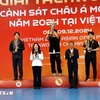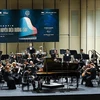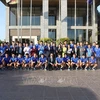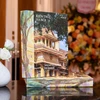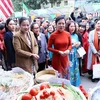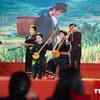Central Thua Thien-Hue province is famous for chanty. Previously, the chanty is popular in all regions of the country, especially in the central region. Chanty is important to the folk type of Vietnam. The Ministry of Culture, Sports and Tourism web portal provides an indepth look at the folk cultural activities full of Hue character.
Chant of husking rice is a very popular cultural folk activities in the rural area of Thua Thien-Hue. This is a type of folks which is performed with exciting rhythm and attracts audiences. On the wide brick yard, surrounded by several rice mortars, artisans (may be directly holding the pestles or not) and performing chanty to the rhythm of the pestle. The part of chanty is called “chorus”.
The attraction of the chant of husking rice, one part comes from the close attachment, exchanges between chanty performers and audiences, or in other words, those who participate in the chanty are performers. The opening part is a folk melody to serve a fixed labour activities (husking rice) the chanty melody is gradually separated from the original purpose which is become a type of letters and arts activities. In the country sides, when finishing husking rice, people still put rice husk into the mortar to pound to take the sound from the pestle to create the rhythm.
* Chant of husking rice – the type of letters and arts full of stage characters
Rice husking chanty not only stops in the meaning of labor and entertainment in rural areas but it also contain many deep meanings. Previously, that is a type of traditional folk letters and arts activities containing musical factors, literature, performing arts, one aesthetic script which is not simple but lyrical and exciting.
Chant of husking rice is a feature of the wet rice culture, which recorded the historic remarks of the past, which reflects the combination of the ethnic groups in labor as well as in other social relations. Under the view of literature, one complete performance of chant of husking rice also reflects one side of the development rule of literature and art of the communities of ethnic groups. In the modern time, the farming as well as other handicrafts which have been nearly mechanised, then leading to some methods of relevant letters and arts attached to labor being fainted. Therefore, researchers also develop cultural heritages of ethnic groups when it is not too late.
Chant of husking rice could be born for long, at the latest in the Dong Son cultural era that the vestiges is the form of sailing, husking rice, blowing a trumpet which are sculptured on the face of the bronze drum. Due to the industrialisation, in the decades at the end of the 20th century, chant of husking rice is nearly separated from the original place and is now on the way to become a type of folk stage in the festivals in rural and urban areas.
Most of villages and communes in Thua Thien-Hue are shortly called Hue, as well as provinces in the north central region, chant of husking rice is offen in parallel with husking rice in the houses of the landowners. In some cases, when running out of rice, but the chanty is still exciting, people put rice husks in the mortar to replace rice for the chanty to continue and sometimes, it last through night. Due to the exciting features of the melodies, and performances, and the aesthetic, lyrical and humorous features of chanty sentences, chant of husking rice attaches to labor in villages, communes, then penetrates into districts, provinces and Hue urban area for many decades in the role of a type of letters and arts full of stage character.
Chant of husking rice in the central region, especially in Huel has appeared in many decades and could be developed at the beginning of the 20th century so the stable and popular features in the melodies, genres of performance, and structures. Therefore, beside in some cases, chanty is performed in the stage in a formal way, most of chant of husking rice is performed in labor and in social life so it has casual features. First and foremost, about the time, it is often that chant of husking rice happens at night, but it does not fix in hour, date and month such as types of stage art such as love duet song, “Den hen lai len” like forms of songs in the spring festivals in the north, “Nho ngay mong 7 thang 3, tro ve hoi Lang tro ra hoi Thay” (Remember on 7 march, returning to Lang festival, and back to Thay festival”. As for time, it can be performed inside the house, in the yard, or in the communal house, or in the market corner, etc.
Chant of husking rice is a amateur type of letters and arts so it does not have coaches or directors or actors or actresses, but are famers, young girls and boys volunteer to be the members of the mortar when husking rice as well as when relaxing. Those are people who have the talent of letters and arts, high polished chanty voice, singing sentences that in each village and commune, there are only several people. They become famous folk singers not through schools but trained by social life. The audiences are laborers and those who live in the village and communes who gather around the mortar under the bamboo groups of the villages.
* Husking rice chanty: the typical features in structure
Chant of husking rice is the replying melody. Each rice mortar has two, four or six people. Each performance of chant of husking rice has three parts: greeting chanty, separating chanty, jumping on the bandwagon chanty. Jumping on the bandwagon chanty is the main part, which is flexible and cheerful; replying chanty sentences are thoughtful, show great warmth, or humorous, naughty, or lyrical. The special feature of the chant of husking rice is that it has the participation of the farmers who has ability to say poetic sentences; replying, performing without thinking.
Despite being taken place in any environment, each complete performance of chant of husking rice in Hue always follows a stable and tight structure in the organization of performance as well as the genres of performing.
As for the organisation of performing: One chanty mortar often has four artisans (two boys and two girls), forming two couples of different sexual chanty teams: one couple of female and male singing out full of deep affection, one couple of female singing out chanty of arresting. The couple singing out chanty of deep affection surrounds the lyrical topic, they seem to be as a couple of boy and girl expressing love and the miss in the relation of a partner or a couple. The couple of chanty of arresting, in the south, it is called arresting to reflect the way of provoking, teasing each other in the couple relation. The poetic sentences of chanty often are folk poems (folk songs) or can be copied basing on the stories of Pham Cong Cuc Hoa, Lam Sanh Xuan Nuong, Kieu, Luc Van Tien to sing. Each couple performs chanty to respond to each other in the scale of the topic which is not direct but in turns come between each other following the form: deep affection – arresting – arresting – deep affection – arresting.
As for the genre and order of performance: the melodies of chant of husking rice in the sound system of national traditional music. During the process of performance, there is not music to support, there are only the sounds of drums to praise, the attractive responding chanty sentences. This type of chanty is performed following the method of co-performance including two sides of “Xuong” and “Xo”. As for “Xuong” side, it is made by an individual but it is not fixed that the members in the mortars in turns participate in performing per the genre of responding for each couple. As for “Xo” side, the group reply by the accompanying sounds such as “ho ho ho ho”, the typical features in the melody of husking rice chanty. The order of a complete performance of chant of husking rice is taken place in the three connected phases: greeting chanty, jumping on the bandwagon chanty, separating chanty.
“Greeting chanty”: Greeting chanty can be also called the opening part, the chanty sentences contain the content of offering and greeting audiences. This chanty phase has the feature of ritual forms replacing the opening sentences of the chanty so the opening sentences of chanty are often for older people or artisans who are famous for chanty. The sentences of husking rice sentences including greeting chanty which are not often smoothly, but simple but very cool and exciting, lyrical because it is the warm-hearted sound of the community of villages and communes in rural areas.
“Jumping on a bandwagon chanty”: after greeting chanty, it is the phase of the main chanty, the key part of the chanty. Each member of the chanty mortar per their topic in turns perform and reply to each other that the artisans make a convention, in which there is “the couple of deep affection and the couple of arresting”.
The couple of deep affection replies to each other in the love relation, in the rhythm of love. Those are the moods of grief, sadness, happiness, missing to share with each other. The responding content likes a love story in the daily life which is poetised as a script in the chanty voice.
Also in the topic of deep affection, artisans can transfer “tuong” chanty or story chanty.
The couple of arresting combining with the couples of deep affection, performing to respond to each other in the contrast relation. The content of the chanty sentences contains many meanings of provoking, challenging each other through the forms of responding. This chanty couple seems to present humor beside the misery of the love of couples.
“Seperating chanty”: all the meetings ends, and so do chanty performances, when separating, it is often loath to part with each other. Separating chanty reflects such moods, and hopes for a meeting in the chanty performances and in social life.-VNA
Chant of husking rice is a very popular cultural folk activities in the rural area of Thua Thien-Hue. This is a type of folks which is performed with exciting rhythm and attracts audiences. On the wide brick yard, surrounded by several rice mortars, artisans (may be directly holding the pestles or not) and performing chanty to the rhythm of the pestle. The part of chanty is called “chorus”.
The attraction of the chant of husking rice, one part comes from the close attachment, exchanges between chanty performers and audiences, or in other words, those who participate in the chanty are performers. The opening part is a folk melody to serve a fixed labour activities (husking rice) the chanty melody is gradually separated from the original purpose which is become a type of letters and arts activities. In the country sides, when finishing husking rice, people still put rice husk into the mortar to pound to take the sound from the pestle to create the rhythm.
* Chant of husking rice – the type of letters and arts full of stage characters
Rice husking chanty not only stops in the meaning of labor and entertainment in rural areas but it also contain many deep meanings. Previously, that is a type of traditional folk letters and arts activities containing musical factors, literature, performing arts, one aesthetic script which is not simple but lyrical and exciting.
Chant of husking rice is a feature of the wet rice culture, which recorded the historic remarks of the past, which reflects the combination of the ethnic groups in labor as well as in other social relations. Under the view of literature, one complete performance of chant of husking rice also reflects one side of the development rule of literature and art of the communities of ethnic groups. In the modern time, the farming as well as other handicrafts which have been nearly mechanised, then leading to some methods of relevant letters and arts attached to labor being fainted. Therefore, researchers also develop cultural heritages of ethnic groups when it is not too late.
Chant of husking rice could be born for long, at the latest in the Dong Son cultural era that the vestiges is the form of sailing, husking rice, blowing a trumpet which are sculptured on the face of the bronze drum. Due to the industrialisation, in the decades at the end of the 20th century, chant of husking rice is nearly separated from the original place and is now on the way to become a type of folk stage in the festivals in rural and urban areas.
Most of villages and communes in Thua Thien-Hue are shortly called Hue, as well as provinces in the north central region, chant of husking rice is offen in parallel with husking rice in the houses of the landowners. In some cases, when running out of rice, but the chanty is still exciting, people put rice husks in the mortar to replace rice for the chanty to continue and sometimes, it last through night. Due to the exciting features of the melodies, and performances, and the aesthetic, lyrical and humorous features of chanty sentences, chant of husking rice attaches to labor in villages, communes, then penetrates into districts, provinces and Hue urban area for many decades in the role of a type of letters and arts full of stage character.
Chant of husking rice in the central region, especially in Huel has appeared in many decades and could be developed at the beginning of the 20th century so the stable and popular features in the melodies, genres of performance, and structures. Therefore, beside in some cases, chanty is performed in the stage in a formal way, most of chant of husking rice is performed in labor and in social life so it has casual features. First and foremost, about the time, it is often that chant of husking rice happens at night, but it does not fix in hour, date and month such as types of stage art such as love duet song, “Den hen lai len” like forms of songs in the spring festivals in the north, “Nho ngay mong 7 thang 3, tro ve hoi Lang tro ra hoi Thay” (Remember on 7 march, returning to Lang festival, and back to Thay festival”. As for time, it can be performed inside the house, in the yard, or in the communal house, or in the market corner, etc.
Chant of husking rice is a amateur type of letters and arts so it does not have coaches or directors or actors or actresses, but are famers, young girls and boys volunteer to be the members of the mortar when husking rice as well as when relaxing. Those are people who have the talent of letters and arts, high polished chanty voice, singing sentences that in each village and commune, there are only several people. They become famous folk singers not through schools but trained by social life. The audiences are laborers and those who live in the village and communes who gather around the mortar under the bamboo groups of the villages.
* Husking rice chanty: the typical features in structure
Chant of husking rice is the replying melody. Each rice mortar has two, four or six people. Each performance of chant of husking rice has three parts: greeting chanty, separating chanty, jumping on the bandwagon chanty. Jumping on the bandwagon chanty is the main part, which is flexible and cheerful; replying chanty sentences are thoughtful, show great warmth, or humorous, naughty, or lyrical. The special feature of the chant of husking rice is that it has the participation of the farmers who has ability to say poetic sentences; replying, performing without thinking.
Despite being taken place in any environment, each complete performance of chant of husking rice in Hue always follows a stable and tight structure in the organization of performance as well as the genres of performing.
As for the organisation of performing: One chanty mortar often has four artisans (two boys and two girls), forming two couples of different sexual chanty teams: one couple of female and male singing out full of deep affection, one couple of female singing out chanty of arresting. The couple singing out chanty of deep affection surrounds the lyrical topic, they seem to be as a couple of boy and girl expressing love and the miss in the relation of a partner or a couple. The couple of chanty of arresting, in the south, it is called arresting to reflect the way of provoking, teasing each other in the couple relation. The poetic sentences of chanty often are folk poems (folk songs) or can be copied basing on the stories of Pham Cong Cuc Hoa, Lam Sanh Xuan Nuong, Kieu, Luc Van Tien to sing. Each couple performs chanty to respond to each other in the scale of the topic which is not direct but in turns come between each other following the form: deep affection – arresting – arresting – deep affection – arresting.
As for the genre and order of performance: the melodies of chant of husking rice in the sound system of national traditional music. During the process of performance, there is not music to support, there are only the sounds of drums to praise, the attractive responding chanty sentences. This type of chanty is performed following the method of co-performance including two sides of “Xuong” and “Xo”. As for “Xuong” side, it is made by an individual but it is not fixed that the members in the mortars in turns participate in performing per the genre of responding for each couple. As for “Xo” side, the group reply by the accompanying sounds such as “ho ho ho ho”, the typical features in the melody of husking rice chanty. The order of a complete performance of chant of husking rice is taken place in the three connected phases: greeting chanty, jumping on the bandwagon chanty, separating chanty.
“Greeting chanty”: Greeting chanty can be also called the opening part, the chanty sentences contain the content of offering and greeting audiences. This chanty phase has the feature of ritual forms replacing the opening sentences of the chanty so the opening sentences of chanty are often for older people or artisans who are famous for chanty. The sentences of husking rice sentences including greeting chanty which are not often smoothly, but simple but very cool and exciting, lyrical because it is the warm-hearted sound of the community of villages and communes in rural areas.
“Jumping on a bandwagon chanty”: after greeting chanty, it is the phase of the main chanty, the key part of the chanty. Each member of the chanty mortar per their topic in turns perform and reply to each other that the artisans make a convention, in which there is “the couple of deep affection and the couple of arresting”.
The couple of deep affection replies to each other in the love relation, in the rhythm of love. Those are the moods of grief, sadness, happiness, missing to share with each other. The responding content likes a love story in the daily life which is poetised as a script in the chanty voice.
Also in the topic of deep affection, artisans can transfer “tuong” chanty or story chanty.
The couple of arresting combining with the couples of deep affection, performing to respond to each other in the contrast relation. The content of the chanty sentences contains many meanings of provoking, challenging each other through the forms of responding. This chanty couple seems to present humor beside the misery of the love of couples.
“Seperating chanty”: all the meetings ends, and so do chanty performances, when separating, it is often loath to part with each other. Separating chanty reflects such moods, and hopes for a meeting in the chanty performances and in social life.-VNA











